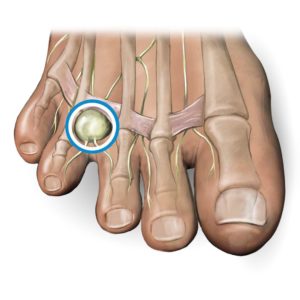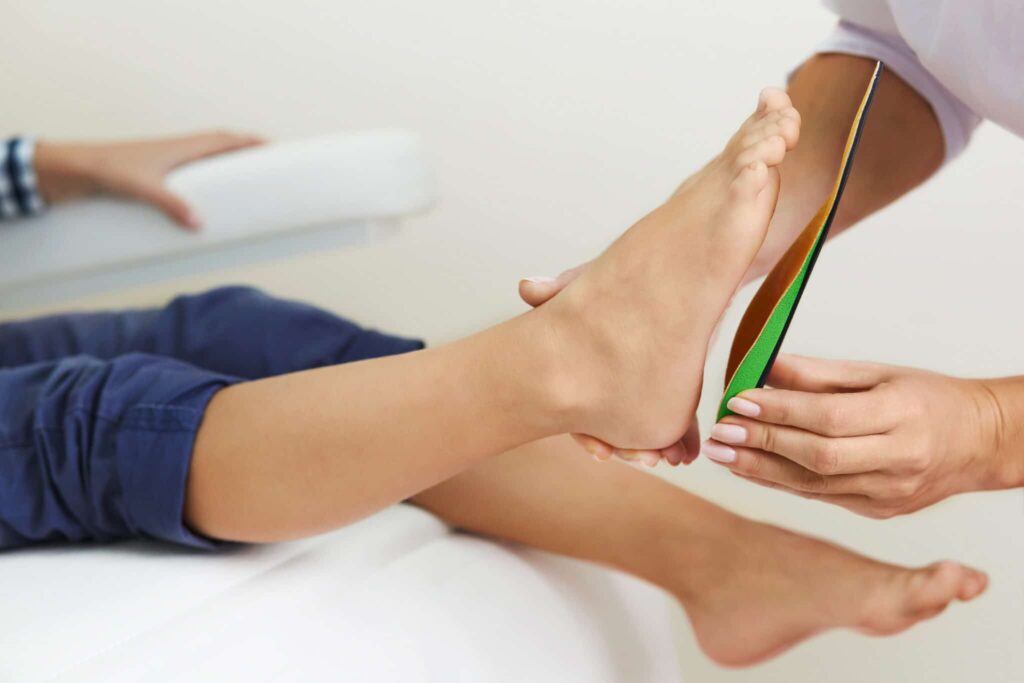Mortons Neuroma
What Is It & How To Fix It
Nerve pain on the ball of your foot?
Toes going numb?
That may be a sign of a Mortons Neuroma
What Is A
Mortons Neuroma
Morton’s neuroma is a growth surrounding a nerve that affects the ball of your foot. It is commonly located in the space between your third and fourth toes. The neuroma compresses the affected nerve, which is what causes the burning and tingling symptoms.
The cause of the growth is due to compression of the nerve by the metatarsal ligament. Over time, this compression leads to an abnormal thickening of the nerve and in some cases, permanent nerve damage.
It is more common among middle-aged patients. Women between the ages of 45 and 60 years old are more likely to develop this condition.

There are variety of symptoms, including:
- Pain: One of the primary symptoms is pain in the ball of the foot. The pain is often described as sharp or burning and may be felt in one or both feet.
- Numbness or tingling: Some people may also experience numbness or tingling in the affected foot or toes.
- People with Morton’s neuroma often describe a sensation. It is like there is a small lump or object under the ball of the foot.
- Radiating pain into the toes, especially the third and fourth toes.
- Worsening pain with activity: Many people experience worsening pain during activities that involve standing, walking, or running.
- Relief with rest: Resting the affected foot can often provide relief from the pain associated with Morton’s neuroma.
- People may have trouble wearing shoes that are too tight or have high heels. This can increase the discomfort they feel.
- Your position and shape; Such as flat feet, high arches, excessive pronation or supination of the foot (rolling in or out)
- Tight fitting footwear like high heels or wide feet
- Bunions that put pressure on shoes
- Hammer Toes
- Exercises that load up the forefoot like, skiing, cycling, running, tennis, dancing, climbing.
Our Locations: Sydney CBD, Mosman, Rose Bay, Dee Why, Ryde
At ModPod we understand foot anatomy and are experts at treating Mortons Neuroma.

Conveniently
Located Clinic
5 Convenient Locations Across Sydney

EXPERIENCE
Treated Over 30,000 Patients

Non-Surgical
Treatments
We Can Help Get You Get Improvement Without Surgery

New Patient
Offer
New Patient Offer – $15 OFF First Visit
Why A Podiatrist Is The
Best Choice For Treating Neuromas
Our podiatrists have extensive knowledge of foot anatomy and foot function. In order to diagnose Morton’s neuroma, we will take your history and foot and leg examination into account. It is important to emphasize that a timely diagnosis can decrease the chance of needing more aggressive treatment
In most cases, diagnosis of a Mortons neuroma can be performed clinically via
- History (looking at your symptoms, activity and footwear)
- Physical examination of your foot
- Biomechanical examination (how your foot is working on the ground)
We may need to refer you to get a diagnostic ultrasound. This ultrasound would confirm the size and location of the neuroma. In some cases, this referral is necessary.
There are a few other conditions which may have similar symptoms.
- Bursitis: Fluid-filled sac pushing on the nerves
- Stress fracture: This is a small crack or break in a bone caused by repetitive stress or overuse.
- Plantar Plate Tear: Damage to the strong ligament under the foot
- Tendonitis: Inflamed tendon
- Contusion: Bruising
Brent Goddard talks about Metatarsalgia and Morton’s Neuroma.

Successful Treatments

Get Back To Activity Sooner

Evidence Based Approach

Walk Pain Free Again

You Are In Safe Hands
See Our Google Reviews
How It We Treat Neuromas
Your podiatrist will start out with a conservative treatment plan and only move on to more aggressive measures if needed. The following list is some of the approaches we take.
- Foot and leg exam to determine the cause
- Prescribing Custom Orthotics or Semi Custom Orthotics
- K-Laser Treatment
- Advise on supportive shoes, to reduce stress around the forefoot
- Exercises that help stretch and loosen the affected ligaments, muscles, and tendons
- Applying cold packs to the ball of your foot
- Referral for a guided cortisone injection

Custom orthotics are medical devices that are designed to provide support, cushioning, and correction to the feet and lower extremities. They are typically made from materials such as foam, plastic, or leather, and are custom-fitted to an individual’s foot shape and gait.
Orthotics can be used to treat a wide range of foot and lower limb conditions, including Mortons Neuroma, plantar fasciitis, flat feet, high arches, and heel spurs. They can also be used to provide support and cushioning for individuals with diabetes or arthritis.
At ModPod we have over 20 years of experience in prescribing orthotics. We would first start with a biomechanical assessment, moving on to a 3d scan of your foot. This scan is sent to our orthotic laboratory who manufactures the orthotic which is ready for fitting after 2 weeks.
A biomechanical examination typically involves the assessment of movement patterns when you are walking or running. The goal is to evaluate how the body is functioning, identify any potential areas of weakness or imbalance, and make recommendations for corrective exercises or treatments.
The examination may include a variety of tests and measurements, such as range of motion assessments, muscle strength, gait analysis, and postural analysis. At ModPod we utilise video treadmill assessments and digital pressure analysis.
Before considering surgery you need to have exhausted all of your conservative treatment options. As with all surgery, there is a risk of complications.
There are several surgical procedures available to treat neuromas, including:
Neuroma Excision: This procedure involves removing the affected nerve tissue completely. It is a common surgical approach and is usually done on an outpatient basis.
Nerve Decompression: This procedure involves releasing the pressure on the nerve and surrounding tissues. The surgeon may remove the ligament or tissue that is pressing on the nerve to relieve the pain.
Your surgeon will decide which procedure is best for you based on your symptoms, medical history, and physical examination.
After the surgery, you may need to wear a surgical shoe or boot and avoid weight-bearing activities for several weeks
Frequently
Asked Questions
While it may not be possible to prevent Morton’s Neuroma entirely, there are steps you can take to reduce your risk of developing the condition. These include wearing comfortable shoes with plenty of room for your toes, avoiding high heels or shoes with pointed toes, and engaging in low-impact exercises that do not put excessive pressure on the feet.
Morton’s Neuroma can be diagnosed through a physical examination and by taking a detailed history. In some cases an ultrasound may be needed to determine the size and location of the neuroma.
The most common symptoms of Morton’s Neuroma include pain in the ball of the foot, tingling or numbness in the toes, a feeling that there is a small pebble or lump in the shoe, and a burning sensation in the toes or ball of the foot.
Surgery might be required if other therapeutic options fail. There are different types of surgery for Morton’s neuroma, and your medical team will choose the best option for you depending on the specific characteristics of your case. This is usually a last resort.
- Wear comfortable shoes with a wide toe box and low heels.
- Apply ice to the affected area for 15-20 minutes at a time, several times a day, to help reduce swelling and pain.
- Take over-the-counter anti-inflammatory medication such as ibuprofen to help reduce pain and inflammation.
- Avoid high-impact activities that put excessive stress on your feet.
- Consider doing foot exercises and stretching to help improve your foot strength and flexibility.
- Massage the affected area to help improve blood flow and reduce tension.
- Consider losing weight if you are overweight, as this can help reduce the amount of pressure on your feet.
Chronic pain: The persistent pain associated with Morton’s neuroma can make it difficult to walk, stand, or engage in physical activity, which can negatively impact your quality of life.
Foot deformities: Over time, Morton’s neuroma can cause the affected toes to become permanently contracted or misaligned, which can lead to other foot deformities.
Nerve damage: In some cases, Morton’s neuroma can cause permanent nerve damage, which can lead to numbness or tingling in the affected area.
Reduced mobility: If your Morton’s neuroma symptoms are severe enough, you may have difficulty walking or standing for extended periods of time, which can limit your mobility and independence.
It is important to seek treatment for Morton’s neuroma to prevent these potential complications from occurring.
If your Morton’s neuroma symptoms persist or worsen despite treatment, it is important to speak with your Podiatrist. Your podiatrist may recommend additional tests, such as an MRI, to further evaluate the condition and rule out other potential causes of your symptoms. They may also recommend a different treatment approach, such as a different type of medication or a more invasive procedure, depending on the severity of your condition.
If your pain is severe and interfering with your daily activities, your podiatrist may refer you to a specialist, such as a orthopedic surgeon, for further evaluation and treatment.
It is important to seek prompt medical attention if your symptoms persist or worsen, as delaying treatment may lead to further complications or permanent nerve damage.







